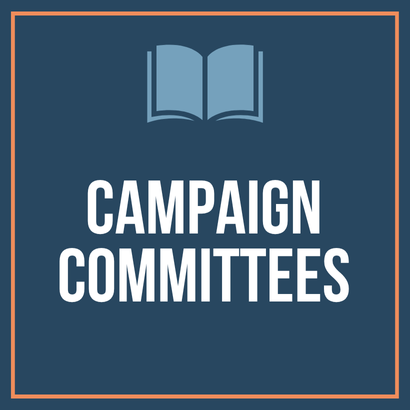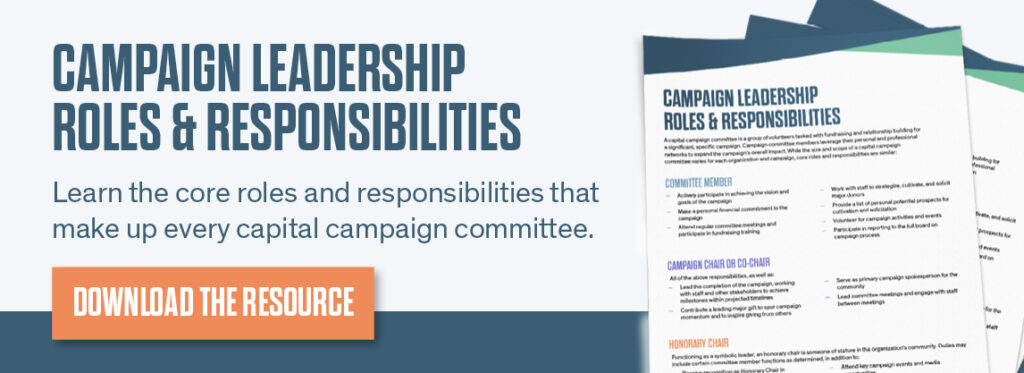CFA’s Guide to Campaign Committees

If your organization is considering a capital, endowment, or capacity building campaign and you are not sure if you can inspire and manage the volunteer manpower necessary to carry out the campaign vision, CFA has assembled the following guide on the purpose and fundamentals of effective nonprofit campaign committee management. Read on for best practices to help harness the power of your team to accomplish your philanthropic goals.
What is a Campaign Committee?
A nonprofit campaign committee, also known as a campaign steering committee, is a group of volunteers tasked with fundraising and relationship building for a significant campaign outside of annual fundraising.
Differences between a Campaign Committee vs. Development Committee
A capital campaign is a fundraising effort for a specific project with a defined timeline, and a campaign committee is the volunteer leadership group tasked with the campaign’s launch, progression, and completion. The campaign committee is often formed from members of a campaign feasibility study committee. Members of a campaign committee are not required to be members of the organization’s board of directors.
Development is an ongoing fundraising activity conducted by staff and development committee volunteers that includes annual giving and major gifts. A development committee is a function of the board of directors of the organization.
Purpose of the Campaign Committee
Campaign volunteers bring an external energy and impact perspective to the campaign. Volunteers view the campaign from the community’s lens and are genuinely invested in the campaign’s broader success. By leveraging their personal and business connections, campaign volunteers can open the door to new donors outside of the organization’s core networks and expand the overall reach of the campaign.
Campaign Committee Structure and Membership
Campaign committee members are well-connected donors who are passionate about your organization’s mission and are committed to helping raise dollars for a special effort. Most will have been involved with the organization and have existing relationships with staff and other volunteers. It is important that committee members have experience giving before they ask others for financial support, so they are often some of the most invested donors and volunteers in your organization. A campaign committee also includes staff liaisons, such as the executive director and development director. The number of people on the committee depends on the size and scope of your organization and campaign, but is typically between 10-20 members.
The volunteers who lead the campaign and committee are referred to as the Campaign Chair or Campaign Co-Chairs, and they make key decisions about the campaign and recruit other committee members. Many campaigns also have an Honorary Campaign Chair.
Campaign Committee Member Responsibilities
- Serve on the committee throughout the campaign (3+ years).
- Make a significant gift to the campaign, based on individual capacity.
- Leverage personal and business connections to recruit campaign support.
- Engage new and prospective donors by sharing campaign information, hosting small gatherings of friends and business associates or on tours of the nonprofit’s facilities, and introducing prospects to other supporters of the organization.
- Follow up with donors and prospects to close the gift.
- Thank donors with phone calls and written correspondence as part of ongoing donor stewardship.

Campaign Committee Engagement
Conducting a campaign provides an opportunity for your organization to engage volunteers in different, deeper facets of the organization. Campaign committee participants have an opportunity to actively mold plans and goals for the organization. There are a number of ways to encourage and inspire your committee members through your campaign:
- Hold regular full committee meetings (bi-monthly or quarterly) and conduct at least one “one-on-one” meeting between the campaign chair(s), staff, and each committee member.
- Provide job descriptions for every committee member as well as the campaign chair(s) and honorary chair(s).
- Plan, manage, and track the work of the committee using a moves management system.
- Inspire committee members by sharing success stories of who your organization has impacted, how different solicitations unfolded, and examples of staff and volunteer achievements.
- Share campaign progress updates at committee meetings, over email, and on internal dashboards to keep volunteers engaged and enthusiastic about the goals and progress.
Campaign Committee Best Practices
- Pause to consider each prospect and where they are in the donor cultivation cycle; don’t rush to make an ask with every prospect simply because you are in campaign mode.
- Ask each committee member to make a personal “stretch” financial gift to the campaign before they ask others to give. Gifts will vary in size based on each individual’s capacity, but the most important metric is that every committee member makes a gift. When 100% of the committee participates in giving to the effort, it sends a strong message to other potential funders that they are seriously committed to the campaign.
When Outside Expertise Can Help
A campaign consultant is a partner to your staff and committee volunteers who helps set the campaign strategy and provides nonprofit fundraising training on how to cultivate, solicit, and close leadership gifts in a campaign.
Experienced fundraising consultants can bring fresh perspectives to share with the nonprofit campaign committee as they have seen what works in other campaign fundraising engagements. Consultants can also provide the systems needed to track progress and ensure every campaign committee member is confident in asking others to support the campaign.
If your organization is considering a campaign, contact Creative Fundraising Advisors today to set your team up for success.
